نمس نحيف
| نمس نحيف Temporal range: أوليگوسين إلى الحاضر
| |
|---|---|

| |
| النمس المصري | |
| التصنيف العلمي | |
| أصنوفة غير معروفة (أصلحها): | Herpestes |
| Type species | |
| Herpestes ichneumon[1] (لينايوس, 1758)
| |
| الأنواع | |
|
انظر الجدول | |
| Synonyms | |
| |
النمس النحيف Herpestes هو جنس من فصيلة النموس Herpestidae. Several species in the family are known as slender mongooses. وهو الجنس النمطي للفصيلة، ويضم 5-6 living species, each with several subspecies. بقايا أحفورية لثلاث أنواع قبل التاريخ اكتـُشِفوا في فرنسا، ووُصِف في 1853.
السمات
The living Herpestes species are sexually dimorphic, with females smaller than males. They range in weight from 0.6 إلى 3.6 kg (1.3 إلى 7.9 lb).[2] They share several characteristics, including the shape of the cheek teeth and of the tympanic bullae, and the presence of the first upper molar teeth. They are all solitary.[3] Males have one chromosome less than females, as one Y chromosome is translocated to an autosome.[4]
التبويب
The scientific name Herpestes was proposed by Johann Karl Wilhelm Illiger in 1811 for mongoose species in the south of the Old World, commonly called "Ichneumon" at the time.[5] Until 1835, 12 mongoose species from Africa and Asia were classified as belonging to the genus Herpestes.[6] In 1864, John Edward Gray listed 22 Herpestes species, which he considered as part of the Viverridae.[7] In 1882, Oldfield Thomas reviewed African mongoose zoological specimens in natural history museums. He subordinated those into the genus Herpestes that have nearly naked soles, four premolars, small last lower molars with two external cusps and whose last upper molars are 40-60% smaller than the last upper premolars. His list comprised eight species in Africa.[8] St. George Jackson Mivart listed 21 Herpestes species, including seven in Africa and 13 in Asia. He also determined Herpestes species by the dentition of mongoose specimens. His criteria included small premolars, small inner cusps of the third upper premolars and transversely extended second upper molars with rather concave posterior margins; their bodies are long with long tails, short legs and five digits to each paw.[9] Wallace Christopher Wozencraft recognised 10 Herpestes species as valid in 2005.[1]
The extinct Herpestes lemanensis was excavated in tertiary depositions in the Loire Valley in central France and described in 1853.[10] It most likely dates to the Late Oligocene.[11]
Phylogenetic analysis of African and Asian mongoose specimens revealed that they belong to three distinct genetic lineages; the two African lineages diverged in the Early Miocene around and , and the Asian Urva lineage at around . The following African mongooses are now placed in the genus Herpestes:[12]
| الصورة | الاسم | الانتشار ووضع IUCN Red List |
|---|---|---|
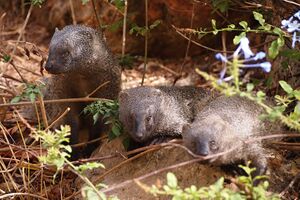
|
نمس مصري (H. ichneumon) (Linnaeus, 1758)[13] | LC[14]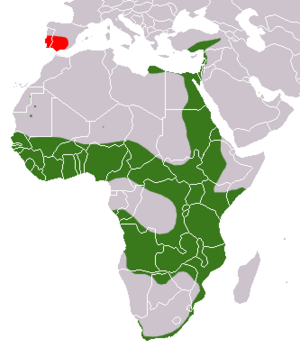
|

|
النمس النحيف الشائع (H. sanguineus) Rüppell, 1835[6] | LC[15]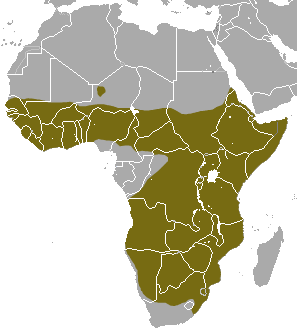
|
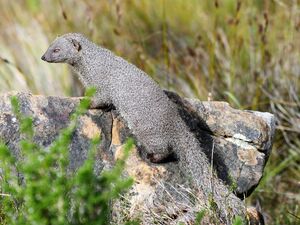
|
Cape gray mongoose (H. pulverulentus) (Wagner, 1839)[16] | LC[17]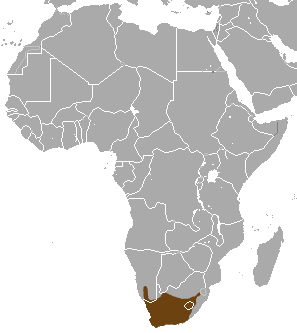
|
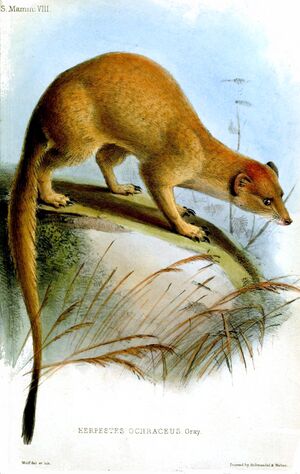
|
النمس النحيف الصومالي (H. ochraceus) Gray, 1848[18] | LC[19]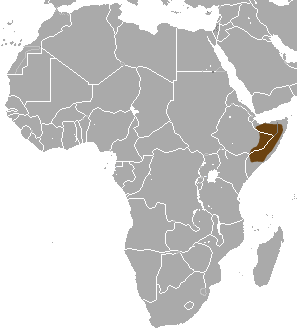
|
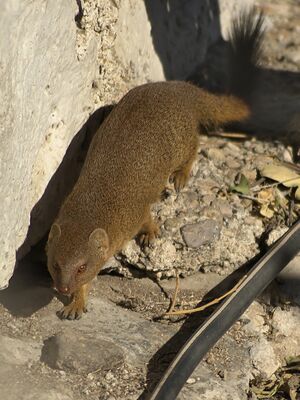
|
Angolan slender mongoose (H. flavescens) (Bocage, 1889)[20] | LC[21]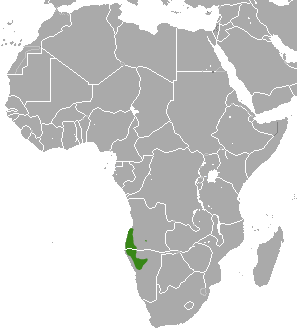
|
المراجع
- ^ أ ب Wozencraft, W. C. (16 November 2005). Wilson, D. E., and Reeder, D. M. (eds) (ed.). Mammal Species of the World (3rd edition ed.). Johns Hopkins University Press. pp. {{{pages}}}. ISBN 0-801-88221-4.
{{cite book}}:|edition=has extra text (help);|editor=has generic name (help); Check date values in:|date=(help)CS1 maint: multiple names: editors list (link) - ^ Taylor, M.E. & Matheson, J. (1999). "A craniometric comparison of the African and Asian mongooses in the genus Herpestes (Carnivora: Herpestidae)". Mammalia. 63 (4): 449–464. doi:10.1515/mamm.1999.63.4.449. S2CID 84384697.
- ^ Veron, G.; Colyn, M.; Dunham, A. E.; Taylor, P. & Gaubert, P. (2004). "Molecular systematics and origin of sociality in mongooses (Herpestidae, Carnivora)" (PDF). Molecular Phylogenetics and Evolution. 30 (3): 582–598. doi:10.1016/S1055-7903(03)00229-X. PMID 15012940.
- ^ Fredga, K. (1977). "Chromosomal Changes in Vertebrate Evolution". Proceedings of the Royal Society of London. Series B, Biological Sciences. 199 (1136): 377–397. doi:10.1098/rspb.1977.0148. JSTOR 77302. PMID 22865. S2CID 32364326.
- ^ Illiger, C. (1815). "Überblick der Säugethiere nach ihrer Verteilung über die Welttheile" [Overview of mammals according to their distribution across the World]. Abhandlungen der physikalischen Klasse der Königlich-Preußischen Akademie der Wissenschaften. 1804−1811: 39−159.
- ^ أ ب Rüppell, E. (1835). "Herpestes. Illiger". Neue Wirbelthiere zu der Fauna von Abyssinien gehörig [New vertebrates belonging to the Fauna of Abyssinia] (in german). Frankfurt am Main: S. Schmerber. pp. 27–32.
{{cite book}}: CS1 maint: unrecognized language (link) - ^ Gray, J.E. (1864). "A revision of the genera and species of Viverrine animals (Viverridae) founded on the collection in the British Museum". Proceedings of the Zoological Society of London (November): 502–579.
- ^ Thomas, O. (1882). "On the African Mungooses". Proceedings of the Zoological Society of London (January): 59–93.
- ^ Mivart, St. G. J. (1882). "On the Classification and Distribution of the Aeluroidea". Proceedings of the Zoological Society of London (February): 135–270.
- ^ Pomel, A. (1853). "Herpestes. Illig.". Catalogue méthodique et descriptif des vertébrés fossiles découverts dans le bassin hydrographique de la Loire. Paris: Baillière. pp. 64–66.
- ^ Lydekker, R. (1887). "Herpestes lemanensis, Pomel". Catalogue of the fossil Mammalia in the British museum, (Natural History). Vol. 5, Supplement. London: British Museum (Natural History). p. 317.
- ^ Patou, M.; Mclenachan, P.A.; Morley, C.G.; Couloux, A.; Jennings, A.P.; Veron, G. (2009). "Molecular phylogeny of the Herpestidae (Mammalia, Carnivora) with a special emphasis on the Asian Herpestes". Molecular Phylogenetics and Evolution. 53 (1): 69–80. doi:10.1016/j.ympev.2009.05.038. PMID 19520178.
- ^ Linnaeus, C. (1758). "Viverra ichneumon". Caroli Linnæi Systema naturæ per regna tria naturæ, secundum classes, ordines, genera, species, cum characteribus, differentiis, synonymis, locis (in اللاتينية). Vol. Tomus I (decima, reformata ed.). Holmiae: Laurentius Salvius. p. 41.
- ^ Do Linh San, E.; Maddock, A.H.; Gaubert, P. & Palomares, F. (2016). "Herpestes ichneumon". IUCN Red List of Threatened Species. 2016: e.T41613A45207211.
- ^ Do Linh San, E. & Maddock, A.H. (2016). "Herpestes sanguineus". IUCN Red List of Threatened Species. 2016: e.T41606A45206143.
- ^ Wagner, J.A. (1839). "Über die Verwandtschafts-Verhältnisse der Pharaonsratte". Gelehrte Anzeigen der Königlich Bayerischen Akademie der Wissenschaften zu München. 9 (183): 425–429.
- ^ Do Linh San, E. & Cavallini, P. (2015). "Herpestes pulverulentus". IUCN Red List of Threatened Species. 2015: e.T41600A45205999.
- ^ Gray, J.E. (1848). "Description of a new species of Herpestes, from Abyssinia". Proceedings of the Zoological Society of London (November): 138–139.
- ^ Taylor, M.E. & Do Linh San, E. (2015). "Herpestes ochraceus". IUCN Red List of Threatened Species. 2015: e.T41605A86159385.
- ^ Bocage, J.V.B. (1889). "Mammifère d'Angola et du Congo". Jornal de Sciencias mathematicas, physicas e naturaes. 2. 1: 174–185.
- ^ Rapson, S. & Rathbun, G.B. (2015). "Herpestes flavescens". IUCN Red List of Threatened Species. 2015: e.T41599A45205933. Retrieved 15 December 2021.